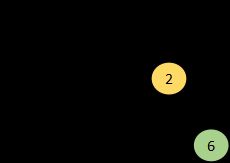libhv学习笔记5:heap.h分析
上一篇分析了libhv里面用到的链表的实现,今天我们看一下定时器超时事件中用到的堆得实现。
堆定义
1.堆中的某个节点总是不大于或不小于其父亲节点
2.堆总是一颗完全二叉树
那么,最大堆就是父节点比每一个子节点值都要大。最小堆就是父节点比每一个子节点值要小。
例子(最小堆)

完全二叉树的定义
对于一个树高为h的二叉树,如果其第0层至第h-1层的节点都满。如果最下面一层节点不满,则所有的节点在左边的连续排列,空位都在右边。这样的二叉树就是一棵完全二叉树
源码分析
结构体的定义
struct heap_node {
struct heap_node* parent; //父节点
struct heap_node* left; //左孩子
struct heap_node* right; //右孩子
};
typedef int (*heap_compare_fn)(const struct heap_node* lhs, const struct heap_node* rhs);
struct heap {
struct heap_node* root; // 根节点
int nelts; // 节点的个数
// if compare is less_than, root is min of heap
// if compare is larger_than, root is max of heap
heap_compare_fn compare;
};
堆初始化
static inline void heap_init(struct heap* heap, heap_compare_fn fn) {
heap->root = NULL;
heap->nelts = 0;
heap->compare = fn; //确定最大堆还是最小堆
}
节点插入
在堆中,节点的插入主要分为两个步骤:
1.将节点插入到堆得尾部。
2.调整节点的位置,使其满足堆得特性。
例如:

调整位置


这就是节点插入的过程,下面看一下libhv怎么处理的
static inline void heap_insert(struct heap* heap, struct heap_node* node) {
// get last => insert node => sift up
// 0: left, 1: right
int path = 0;
int n,d;
++heap->nelts;
// traverse from bottom to up, get path of last node
for (d = 0, n = heap->nelts; n >= 2; ++d, n>>=1) {
path = (path << 1) | (n & 1);
}
// get last->parent by path
struct heap_node* parent = heap->root;
while(d > 1) {
parent = (path & 1) ? parent->right : parent->left;
--d;
path >>= 1;
}
// insert node
node->parent = parent;
if (parent == NULL) heap->root = node;
else if (path & 1) parent->right = node;
else parent->left = node;
// sift up
if (heap->compare) {
while (node->parent && heap->compare(node, node->parent)) {
heap_swap(heap, node->parent, node);
}
}
}
过程就是
// get last => insert node => sift up
先看怎么get last,也就是获取节点插入的位置
// traverse from bottom to up, get path of last node
for (d = 0, n = heap->nelts; n >= 2; ++d, n>>=1) {
path = (path << 1) | (n & 1);
}
这里是获取插入节点的路径,从根出发,沿怎样的路径找到插入的位置。
辅以图讲解

现在我们要插入节点7。
那么 n= heap->nelts = 7. 各变量的变化过程是:
n:7 ▶ 3 ▶ 1
d:0 ▶ 1 ▶ 2
path:0001 ▶0011
此时得到的路径为11B,0为左孩子,1为右孩子,也就是说,从根出发,根的右孩子,右孩子的右孩子
看一下代码
// get last->parent by path
struct heap_node* parent = heap->root;
while(d > 1) {
parent = (path & 1) ? parent->right : parent->left;
--d;
path >>= 1;
}
那么parent指向的就是3节点
插入节点
// insert node
node->parent = parent; //设置父节点
if (parent == NULL) heap->root = node; //如果父节点为NULL,说明新加入的节点是根结点
else if (path & 1) parent->right = node; //新加入的节点是其父节点的右结点
else parent->left = node; //新加入的节点是其父节点的左节点
接下来就是调整位置,使其满足堆得定义
if (heap->compare) {
while (node->parent && heap->compare(node, node->parent)) {
heap_swap(heap, node->parent, node); //交换节点与父节点
}
}
static inline void heap_swap(struct heap* heap, struct heap_node* parent, struct heap_node* child) {
assert(child->parent == parent && (parent->left == child || parent->right == child));
//parent的父节点
struct heap_node* pparent = parent->parent;
//child的左孩子
struct heap_node* lchild = child->left;
//child的右孩子
struct heap_node* rchild = child->right;
struct heap_node* sibling = NULL;
//[parent的父节点更换孩子为child]
//如果parent的父节点为空,说明parent是根节点
if (pparent == NULL) heap->root = child;
//如果parent是父节点的左孩子,则把左孩子指向child
else if (pparent->left == parent) pparent->left = child;
//如果parent是父节点的右孩子,则把右孩子指向child
else if (pparent->right == parent) pparent->right = child;
//[child的孩子更换父节点]
//如果child有左孩子,则把左孩子指向parent
if (lchild) lchild->parent = parent;
//如果child有左孩子,则把左孩子指向parent
if (rchild) rchild->parent = parent;
//child更换parent
child->parent = pparent;
//如果child是parent的左孩子,则把parent的变为child的左孩子
if (parent->left == child) {
sibling = parent->right;
child->left = parent;
child->right = sibling;
}
//如果child是parent的右孩子,则把parent的变为child的右孩子
else {
sibling = parent->left;
child->left = sibling;
child->right = parent;
}
//将parent另一个孩子的父节点改为child
if (sibling) sibling->parent = child;
parent->parent = child;
parent->left = lchild;
parent->right = rchild;
}
节点删除
static inline void heap_remove(struct heap* heap, struct heap_node* node) {
if (heap->nelts == 0) return;
// get last => replace node with last => sift down and sift up
// 0: left, 1: right
int path = 0;
int n,d;
// traverse from bottom to up, get path of last node
//获取最后一个节点的路径
for (d = 0, n = heap->nelts; n >= 2; ++d, n>>=1) {
path = (path << 1) | (n & 1);
}
--heap->nelts;
// get last->parent by path
//获取最后一个节点的父节点
struct heap_node* parent = heap->root;
while(d > 1) {
parent = (path & 1) ? parent->right : parent->left;
--d;
path >>= 1;
}
// replace node with last
struct heap_node* last = NULL;
if (parent == NULL) {
return;
}
//获取最后一个节点,并在堆中将该位置赋值为NULL,相当于把node删除了
else if (path & 1) {
last = parent->right;
parent->right = NULL;
}
else {
last = parent->left;
parent->left = NULL;
}
//说明只有一个根节点
if (last == NULL) {
if (heap->root == node) {
heap->root = NULL;
}
return;
}
//交换node和last
heap_replace(heap, node, last);
node->parent = node->left = node->right = NULL;
if (!heap->compare) return;
struct heap_node* v = last;
struct heap_node* est = NULL;
// sift down
//last有可能比过去node的孩子结点大,那么需要将last向下移动
while (1) {
est = v;
if (v->left) est = heap->compare(est, v->left) ? est : v->left;
if (v->right) est = heap->compare(est, v->right) ? est : v->right;
if (est == v) break;
heap_swap(heap, v, est);
}
// sift up
//last有可能比过去node的父结点小,那么需要将last向上移动
while (v->parent && heap->compare(v, v->parent)) {
heap_swap(heap, v->parent, v);
}
}
删除的大体过程就是,把删除的节点和最后一个节点交换,然后再调整交换后的节点的位置,使其满足堆得定义。
// replace s with r
static inline void heap_replace(struct heap* heap, struct heap_node* s, struct heap_node* r) {
// s->parent->child, s->left->parent, s->right->parent
//s为根节点
if (s->parent == NULL) heap->root = r;
//如果s是父节点的左孩子,则r变为s左孩子
else if (s->parent->left == s) s->parent->left = r;
//如果s是父节点的右孩子,则r变为s右孩子
else if (s->parent->right == s) s->parent->right = r;
//把s的孩子的父节点变为r
if (s->left) s->left->parent = r;
if (s->right) s->right->parent = r;
r的父节点,孩子节点变为s的父节点和孩子节点
if (r) {
//*r = *s;
r->parent = s->parent;
r->left = s->left;
r->right = s->right;
}
}
删除根节点
static inline void heap_dequeue(struct heap* heap) {
heap_remove(heap, heap->root);
}
再看一下堆在定时器结构体里的应用
#define HTIMER_FIELDS \
HEVENT_FIELDS \
uint32_t repeat; \
uint64_t next_timeout; \
struct heap_node node;
struct htimer_s {
HTIMER_FIELDS
};
#define TIMER_ENTRY(p) container_of(p, htimer_t, node)
和链表使用的思想是一样的。
以上就是libhv里堆的实现。
